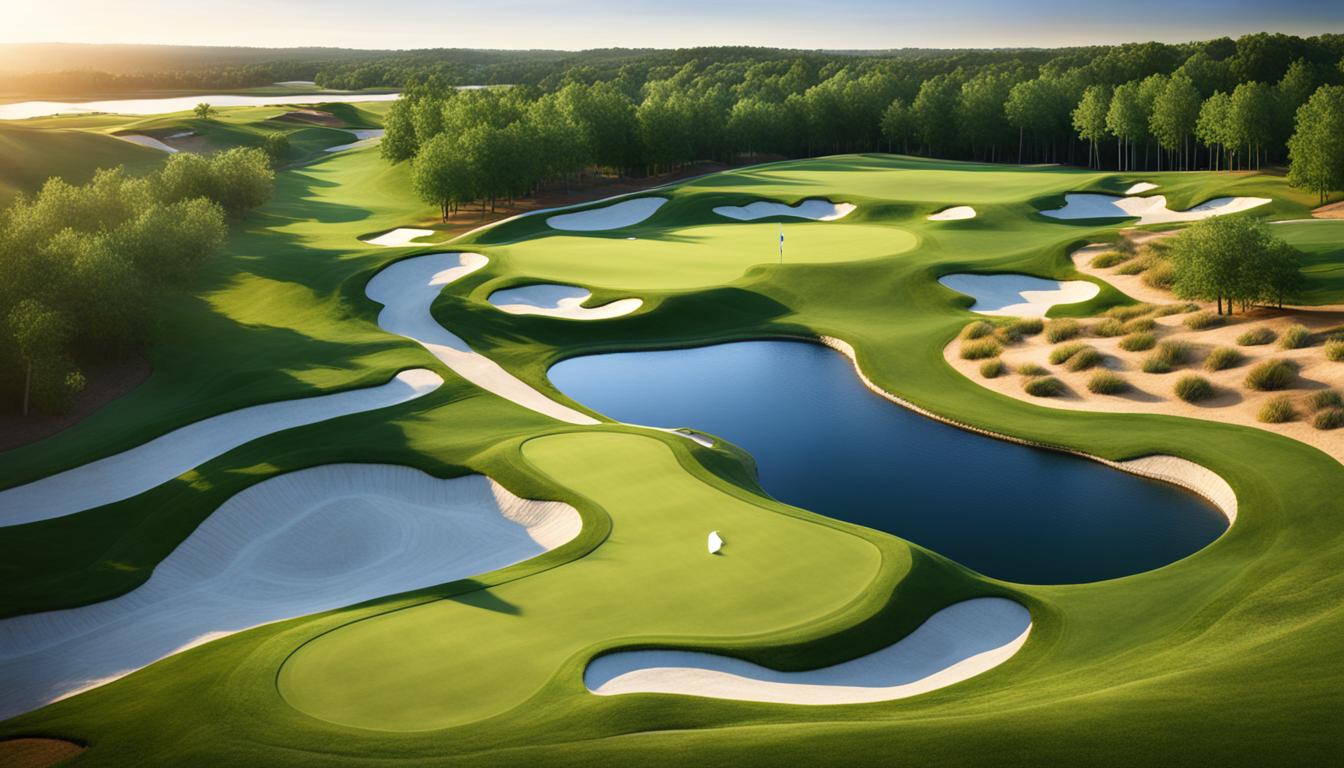Welcome to our article on the exciting world of golf course architecture and landscaping! In this section, we will explore the importance of golf course design, construction, and renovation, as well as the strategies and techniques used to create sustainable and visually stunning golfing environments. Whether you’re a golf enthusiast or an industry professional, join us as we delve into the fascinating realm of golf course architecture and landscaping.
Key Takeaways:
- Golf course architecture and landscaping are vital for creating sustainable and visually appealing golfing environments.
- Renovation projects enhance playability and address challenges related to climate and maintenance.
- Golf course architects combine artistry with agronomic knowledge to shape the future of golf course design.
- Sustainable golf course design and eco-friendly landscaping practices are becoming increasingly important in the industry.
- Strategic planning, diversity in playing experiences, and respect for the course’s uniqueness are key considerations in golf course renovation.
The Importance of Golf Course Renovation
Golf courses play an essential role in providing enjoyable and challenging experiences for golfers. However, over time, these courses can become worn out and fail to meet the evolving needs of players. That’s where golf course renovation comes into play. Regular evaluation and improvement of golf courses are necessary to maintain their quality, sustainability, and playability. Let’s explore the reasons why golf course renovation is of utmost importance.
Enhanced Playability and Maintenance
Golf course maintenance staff face increased stress as the number of players grow. Wear and tear on the course, especially the greens, tees, and bunkers, can significantly impact playability. To address these issues, golf course superintendents need to make necessary modifications through renovation. These may include:
- Enlarging tees to accommodate larger crowds
- Improving surface drainage to prevent standing water
- Adjusting green sizes to combat compaction
By implementing these improvements, golf courses can ensure better playing conditions and reduce challenges posed by routine maintenance tasks.
Adapting to Technological Advances
The game of golf has witnessed numerous technological advancements over the years, such as the introduction of longer golf balls and the use of golf carts. These advancements impact the design and infrastructure of golf courses. Renovation projects allow golf course architects and designers to adapt the course to these changes effectively. For instance, redesigning fairways and greens can accommodate longer shots, while upgrading cart paths enhances player convenience.
Meeting the Expectations of Golfers
Golf course renovation is also essential for meeting the expectations of modern golfers. With the rise of televised tournaments and the desire for tournament-like playing conditions, golfers increasingly look for courses that provide an exceptional experience. Renovation projects allow golf courses to enhance their aesthetics, design, and landscaping to create more challenging and visually stunning holes.
Preserving Course Heritage
Many golf courses have a rich heritage and storied pasts. Renovation projects provide an opportunity to preserve and honor the unique character of these courses. Golf course architects and designers work diligently to maintain the historical significance of the course while incorporating modern design principles. This careful balance between tradition and innovation allows golfers to enjoy the best of both worlds.
Overall, golf course renovation is a vital process that ensures golf courses remain relevant, challenging, and visually appealing. Through regular evaluation and improvements, golf course owners and operators can provide an outstanding golfing experience for players of all skill levels.
The Art of Golf Course Architecture
When it comes to golf course renovation and design, Andrew Green stands out as a true artist in the field. As a renowned golf course architect, Green has made a name for himself by specializing in transforming existing golf courses into stunning masterpieces. With a passion for the game and an eye for detail, he combines his expertise in golf course architecture with his ability to envision fairway contours, bunker placements, and green locations that elevate the golfing experience.
What sets Green apart is his hands-on approach to his craft. Not only does he utilize specialized software applications to create detailed designs, but he also operates a bulldozer himself to bring his visions to life. This unique skill set allows him to seamlessly merge his artistic vision with practical execution, resulting in golf courses that are not only aesthetically pleasing but also strategically challenging.
“Golf course architecture is about creating an experience for players and preserving the spirit of the game. It’s not just about designing holes but also understanding the unique characteristics of each site. By incorporating elements of nature, history, and player expectations, we can breathe new life into old courses and create a golfing experience that stands the test of time,” says Green.
One of Green’s notable projects was the renovation of the East Course at Oak Hill Country Club. Treading carefully to maintain the course’s historical significance, he seamlessly integrated modern design principles while preserving the charm and character that Oak Hill is known for. By incorporating sustainable practices and paying tribute to the course’s legacy, Green successfully connected the past to the future, earning accolades from the club’s leadership and players alike.
Born and raised on a farm, Green’s background taught him the value of hard work, perseverance, and attention to detail. His education at Virginia Tech further honed his skills and allowed him to develop a strong network within the golfing community. Today, he is recognized as one of the golf course architecture industry’s leading figures, sought after by golf clubs and restoration experts around the world.

Notable Projects by Andrew Green
| Course | Location | Description |
|---|---|---|
| East Course at Oak Hill Country Club | Rochester, New York, USA | Renovation that seamlessly blends historical significance with modern design principles, earning global recognition |
| Interlachen Country Club | Edina, Minnesota, USA | Renovation project focusing on enhancing playability and strategic options for golfers |
| East Lake Golf Club | Atlanta, Georgia, USA | Renovation that transformed the course into a world-class venue, hosting prestigious tournaments |
Success Stories in Golf Course Renovation
Andrew Green’s work at Oak Hill Country Club has garnered widespread acclaim and admiration within the golfing community. His expertise in golf course renovation and restoration has earned him a reputation as a notable golf course architect.
“Green’s renovation efforts at Oak Hill were nothing short of impressive. He perfectly balanced preserving the course’s rich history while incorporating modern design principles.”
- Club leadership commended Green’s attention to detail and commitment to maintaining the course’s character.
- Media outlets hailed the transformation, praising Green’s ability to enhance playability and aesthetic appeal.
- Players participating in the prestigious PGA Championship raved about the improved course conditions and strategic design choices.
Green’s success at Oak Hill opened doors to work on other esteemed golf courses. Notable projects in his portfolio include the Interlachen Country Club and the East Lake Golf Club. His ability to seamlessly blend historical significance with modern design principles has made him highly sought-after in the golf industry.
Green attributes his success to his education at Virginia Tech, where he honed his skills and gained a deep understanding of golf course architecture. Beyond academia, his extensive network of contacts in the golf community has played a crucial role in his career advancement and the opportunities that have come his way.
Conclusion
Golf course architecture and landscaping are vital elements in creating sustainable and visually appealing golfing environments. Renovation projects, led by passionate and skilled architects like Andrew Green, allow golf courses to adapt to changing climates, technologies, and player expectations. By addressing water retention issues and designing strategic and diverse playing experiences, golf course renovations enhance the overall golfing experience.
Furthermore, these renovations not only improve playability but also preserve the unique character of each golf course. With a focus on sustainability and a respectful approach to the past, architects ensure that the history and legacy of these courses are upheld while incorporating modern design principles. The artistry and agronomic knowledge combined by these architects shape the future of golf course design and landscaping.
As the demand for more eco-friendly practices and sustainable golf courses rises, architects play a crucial role in meeting these expectations. Through innovative design solutions and utilization of environmentally-friendly materials, they create landscapes that harmonize with nature. This commitment to sustainability not only benefits the environment but also enhances the enjoyment of golf for players and ensures the long-term viability of the sport.
FAQ
What are some common challenges faced by golf courses?
Golf courses often face challenges related to climate and maintenance. This can include issues with water retention, drainage, and wear-and-tear on the turf.
Why is golf course renovation important?
Golf courses need regular evaluation and renovation to keep up with changing trends in the game and the expectations of golfers. Renovations are necessary to maintain playability, address wear-and-tear, and accommodate technological advancements.
Who is Andrew Green and what is his expertise?
Andrew Green is a renowned golf course architect known for his expertise in renovating existing golf courses. He combines his passion for the game with his ability to envision fairway contours, bunker placements, and green locations.
What projects has Andrew Green worked on?
Andrew Green has worked on notable projects such as the renovation of the East Course at Oak Hill Country Club, Interlachen Country Club, and East Lake Golf Club. His work has received global recognition and positive feedback.
How does golf course architecture contribute to sustainability?
Golf course architecture and landscaping play a crucial role in creating sustainable and visually appealing golfing environments. Renovations can address issues such as water retention and promote eco-friendly practices.



